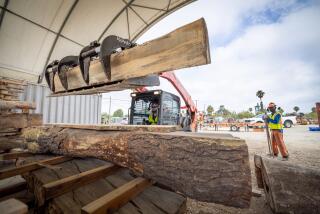Debate Renewed on N. Calif. Logging
New plans to cut trees in Northern Californiaâs redwood country are reigniting the controversy surrounding the Headwaters Forest Preserve, the subject of a $480-million state and federal acquisition in 1999.
A state senator who helped draft the deal says that plans by Pacific Lumber Co. violate terms of the pact that extended protection to areas of the forest that are still owned by the logging firm.
The company wants to harvest trees in parts of the forest known to shield the marbled murrelet, a rare bird protected by federal and state endangered species laws. Timber company officials counter that cutting is allowed by the 1999 agreement. They say that logging could help the birds because thinning the forest would let in more light and water that would allow nesting trees to flourish.
The birds like to build their nests on the broad limbs of giant redwoods. âThe whole idea here is that this is a win-win,â said the companyâs executive vice president and general counsel, Jared G. Carter. âIn 30 years, those trees that were left would be a whole lot bigger.â
Some biologists who toured the Pacific Lumber site last Friday remain skeptical, saying that any benefits for the bird are uncertain at best. âWe clarified that they would have to demonstrate to us that entering these stands would be beneficial to the marbled murrelet and its habitat,â said Bill Condon, biologist with the state Department of Fish and Game. âThey have some homework to do.â
The state Department of Forestry is reviewing the new Pacific Lumber plan to thin trees in two areas totaling 76 acres in the Allen Creek area, southeast of the Headwaters preserve near Carlotta. Trees to be cut are second-growth redwoods and some Douglas fir. Old-growth redwoods scattered through the forest would not be cut.
The plan marks the first time the company has proposed logging in one of 10 areas on its land protected as murrelet habitat in the 1999 deal.
The areas have been dubbed âlesser cathedralsâ because they are much smaller than the famed 7,500-acre Headwaters Forest that was acquired from Pacific Lumber. However, the adjacent groves still contain some old-growth redwoods dating back at least three centuries. Marbled murrelets nest primarily in old-growth forests that are vanishing so rapidly from the North Coast that even scattered old redwoods are considered key if the bird is to escape extinction.
Among those most opposed to logging around Allen Creek is state Sen. Byron Sher (D-Stanford), who helped write conditions governing the stateâs $130-million contribution to the Headwaters deal. Among those conditions were protections for the murrelet areas.
âThey were giving up the right to harvesting,â said Sher, chairman of the Senate Environmental Quality Committee. In a strongly worded letter to the state director of forestry, Sher says the state prohibited any timber harvesting for 50 years within the murrelet areas.
The 1998 state legislation authorizing the Headwaters purchase says the final pact âshall prohibit timber harvesting, including salvage logging and other management activities that are detrimental to the marbled murrelet habitat in the Marbled Murrelet Conservation Areas for the life of the . . . permits.â Those permits are in effect for 50 years.
But Pacific Lumber reads that same sentence differently, saying it allows cutting so long as it doesnât hurt the rare bird or its habitat.
Other restrictive language permits thinning within the murrelet areas âonly on a case-by-case basis and only if the wildlife agencies determine that the specific activity will be beneficial to the marbled murrelet and its habitat.â
At Pacific Lumber, Carter says the Allen Creek logging plan would benefit the bird by speeding tree growth. State and federal biologists charged with reviewing the plan remain unconvinced.
Staff biologists with the Arcata office of the U.S. Fish and Wildlife Service acknowledged that thinning could promote tree growth, but they said the benefits for the murrelets might not be evident for 30 years or even longer, after the 50-year agreement expires and Pacific Lumber can legally cut the trees.
âThatâs the rub,â said Fish and Wildlife Service biologist Gary Falxa, who visited Allen Creek. âThe benefits seem, at the best, long-term.â
If the Allen Creek trees are thinned, those that remain may develop thicker crowns that potentially could shield nesting murrelets from high winds and other threats, Condon said.
But the thinning could open stands of trees to harsh winds and to predators such as crows and ravens that eat young murrelets. The mechanics of tree-cutting can damage the crowns and branches of trees left standing, Condon said.
More to Read
Sign up for Essential California
The most important California stories and recommendations in your inbox every morning.
You may occasionally receive promotional content from the Los Angeles Times.









